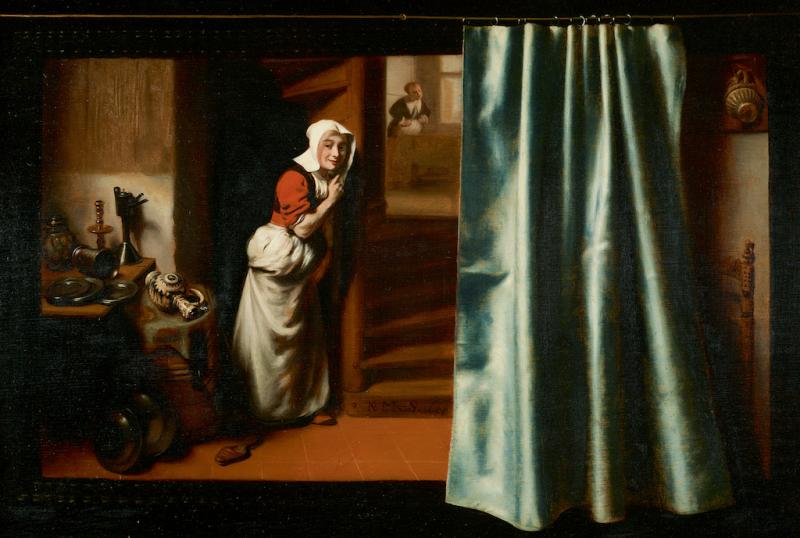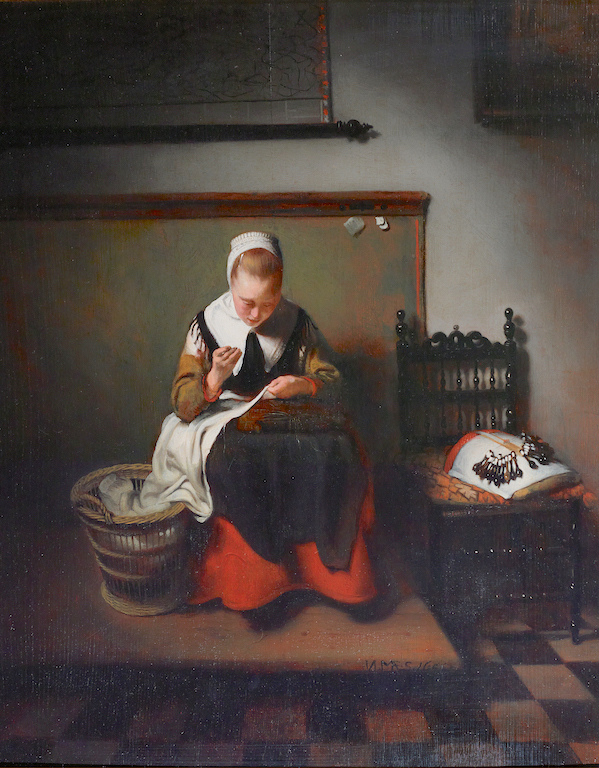Nicolaes Maes: Dutch Master of the Golden Age, National Gallery review – beautifully observed vignettes | reviews, news & interviews
Nicolaes Maes: Dutch Master of the Golden Age, National Gallery review – beautifully observed vignettes
Nicolaes Maes: Dutch Master of the Golden Age, National Gallery review – beautifully observed vignettes
The theatre of domestic life in 17th century Holland

A young woman sits sewing (pictured below right: Young Woman Sewing,1655). She is totally immersed in her task, and our attention is similarly focused on her and every detail of her environment. The cool light pouring though the window illuminates her work and also gives us a clear view.
This exquisite painting is as much about looking and attending to detail as it is about domestic work; and the respect Nicolaes Maes confers on this humble scene lends it an almost religious aura. Enthroned on her dais, the young seamstress is accorded the dignity of a Renaissance Madonna. Working in Dordrecht in mid 17th century Holland, Maes had created a genre that would inspire Vermeer to paint similarly serene pictures of young women reading or playing the virginals.
 In the meantime, though, Maes had begun jazzing up his pictures by introducing an element of drama or comedy. Take The Eavesdropper, 1655 (main picture). It’s like a still from the 17th century equivalent of Upstairs Downstairs. Hiding in the stairwell, the maid is eavesdropping on her mistress, who can be seen in the far room apparently giving someone a dressing down. The recipient of the tongue lashing is hidden from view by a blue satin curtain that obscures almost half the picture. We could almost be sitting in a theatre as the curtain is drawn back to reveal the start of Act I.
In the meantime, though, Maes had begun jazzing up his pictures by introducing an element of drama or comedy. Take The Eavesdropper, 1655 (main picture). It’s like a still from the 17th century equivalent of Upstairs Downstairs. Hiding in the stairwell, the maid is eavesdropping on her mistress, who can be seen in the far room apparently giving someone a dressing down. The recipient of the tongue lashing is hidden from view by a blue satin curtain that obscures almost half the picture. We could almost be sitting in a theatre as the curtain is drawn back to reveal the start of Act I.
The maid is all ears and, to ensure we don’t miss a thing, she signals to us to keep quiet and listen. We have become co-conspirators in the drama. Maes painted six different versions of The Eavesdropper, all of which feature a woman (sometimes the mistress, sometimes a maid) inviting the viewer to join her in spying on members of the household; this is the only one, though, with a curtain painted across it to highlight the theatricality of the moment.
Maes borrowed the idea from Rembrandt, who used the trompe l’oeil device in his 1646 painting of The Holy Family, which appears to have a red velvet curtain hanging from the frame. Maes was one of Rembrandt’s star pupils; he learned to imitate the techniques and subject matter of his teacher and was so successful that several of his early pictures were once attributed to Rembrandt. Among them is The Apostle Thomas. Painted in 1656, three years after he’d left Rembrandt’s studio, it still retains the subtle tonalities and impressionistic brushstrokes learned from his teacher. The sitter’s left hand is the only things in sharp focus; the set square he holds in it alludes to a key incident in his life. Commissioned to build a palace for an Indian prince, Thomas supposedly gave the money to the poor, while assuring his irate client that he would be rewarded with a palace in heaven. A painting that appears to be a straightforward portrait of an old man is enriched by subtle clues about the subject’s backstory.
It’s a beautiful picture, but Maes would have remained an anonymous “follower of Rembrandt”, had he not branched out and pioneered the genre pictures that followed. The National Gallery’s exhibition reveals another dramatic switch, though. In 1673 Maes returned to Amsterdam and embarked on yet another phase, as a portrait painter. Such was his success that, in order to fulfil his commissions – he completed some 900 portraits – elements like the posture and clothing of sitters were standardised so that he could churn out their likenesses.
 His ability to capture the look and feel of fabrics and other materials was well established. Now, inspired by Van Dyck, he began painting his sitters in front of elaborate backdrops and dressing them in rippling velvets and shining satins. To 21st century eyes, the results can seem ludicrous. A young girl dressed in blue satin, for instance, collects water dripping from a rock while cuddling a deer; in the companion picture (pictured left}, a chubby boy is decked out as a Roman hunter, in cream and orange satin with matching sandals. Are his arrows destined to kill her pet deer, I wonder?
His ability to capture the look and feel of fabrics and other materials was well established. Now, inspired by Van Dyck, he began painting his sitters in front of elaborate backdrops and dressing them in rippling velvets and shining satins. To 21st century eyes, the results can seem ludicrous. A young girl dressed in blue satin, for instance, collects water dripping from a rock while cuddling a deer; in the companion picture (pictured left}, a chubby boy is decked out as a Roman hunter, in cream and orange satin with matching sandals. Are his arrows destined to kill her pet deer, I wonder?
Alongside these fripperies, though, he also painted sober portraits of Jacob Tripp and his wife Margaretha de Geer, whom Rembrandt also portrayed. And they reveal that he hadn’t forgotten the lessons learned from his master, some 20 years earlier. This splendid exhibition thereby reveals not just the twists and turns in one artist’s career, but the compromises he made in order to accommodate his client’s tastes. I’d love to know his thoughts on these various shifts in style and what necessitated them. If only he were alive, it would be fascinating to interview him!
rating
Share this article
The future of Arts Journalism
You can stop theartsdesk.com closing!
We urgently need financing to survive. Our fundraising drive has thus far raised £49,000 but we need to reach £100,000 or we will be forced to close. Please contribute here: https://gofund.me/c3f6033d
And if you can forward this information to anyone who might assist, we’d be grateful.

Subscribe to theartsdesk.com
Thank you for continuing to read our work on theartsdesk.com. For unlimited access to every article in its entirety, including our archive of more than 15,000 pieces, we're asking for £5 per month or £40 per year. We feel it's a very good deal, and hope you do too.
To take a subscription now simply click here.
And if you're looking for that extra gift for a friend or family member, why not treat them to a theartsdesk.com gift subscription?
more Visual arts
 'We are bowled over!' Thank you for your messages of love and support
Much-appreciated words of commendation from readers and the cultural community
'We are bowled over!' Thank you for your messages of love and support
Much-appreciated words of commendation from readers and the cultural community
 Lee Miller, Tate Britain review - an extraordinary career that remains an enigma
Fashion photographer, artist or war reporter; will the real Lee Miller please step forward?
Lee Miller, Tate Britain review - an extraordinary career that remains an enigma
Fashion photographer, artist or war reporter; will the real Lee Miller please step forward?
 Kerry James Marshall: The Histories, Royal Academy review - a triumphant celebration of blackness
Room after room of glorious paintings
Kerry James Marshall: The Histories, Royal Academy review - a triumphant celebration of blackness
Room after room of glorious paintings
 Folkestone Triennial 2025 - landscape, seascape, art lovers' escape
Locally rooted festival brings home many but not all global concerns
Folkestone Triennial 2025 - landscape, seascape, art lovers' escape
Locally rooted festival brings home many but not all global concerns
 Sir Brian Clarke (1953-2025) - a personal tribute
Remembering an artist with a gift for the transcendent
Sir Brian Clarke (1953-2025) - a personal tribute
Remembering an artist with a gift for the transcendent
 Emily Kam Kngwarray, Tate Modern review - glimpses of another world
Pictures that are an affirmation of belonging
Emily Kam Kngwarray, Tate Modern review - glimpses of another world
Pictures that are an affirmation of belonging
 Kiefer / Van Gogh, Royal Academy review - a pairing of opposites
Small scale intensity meets large scale melodrama
Kiefer / Van Gogh, Royal Academy review - a pairing of opposites
Small scale intensity meets large scale melodrama
 Jenny Saville: The Anatomy of Painting, National Portrait Gallery review - a protégé losing her way
A brilliant painter in search of a worthwhile subject
Jenny Saville: The Anatomy of Painting, National Portrait Gallery review - a protégé losing her way
A brilliant painter in search of a worthwhile subject
 Abstract Erotic, Courtauld Gallery review - sculpture that is sensuous, funny and subversive
Testing the boundaries of good taste, and winning
Abstract Erotic, Courtauld Gallery review - sculpture that is sensuous, funny and subversive
Testing the boundaries of good taste, and winning
 Edward Burra, Tate Britain review - watercolour made mainstream
Social satire with a nasty bite
Edward Burra, Tate Britain review - watercolour made mainstream
Social satire with a nasty bite
 Ithell Colquhoun, Tate Britain review - revelations of a weird and wonderful world
Emanations from the unconscious
Ithell Colquhoun, Tate Britain review - revelations of a weird and wonderful world
Emanations from the unconscious
 Rachel Jones: Gated Canyons, Dulwich Picture Gallery review - teeth with a real bite
Mouths have never looked so good
Rachel Jones: Gated Canyons, Dulwich Picture Gallery review - teeth with a real bite
Mouths have never looked so good

Add comment